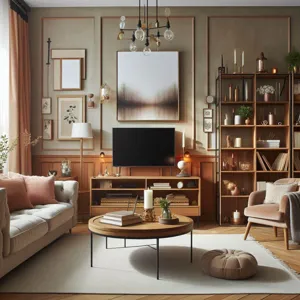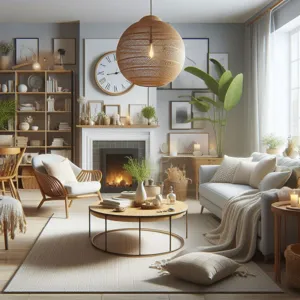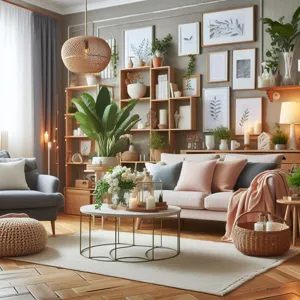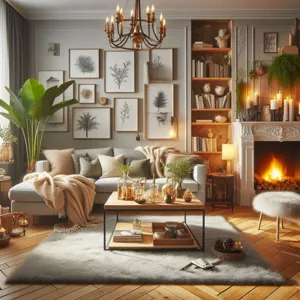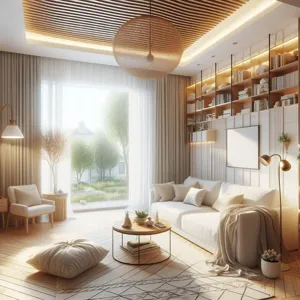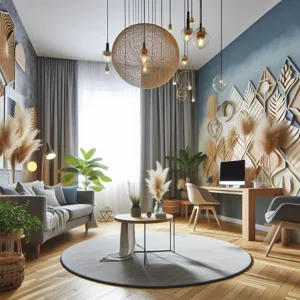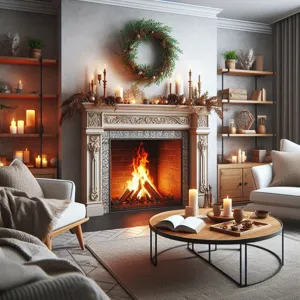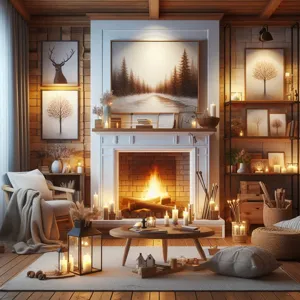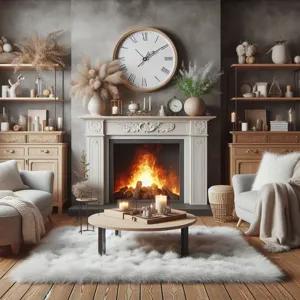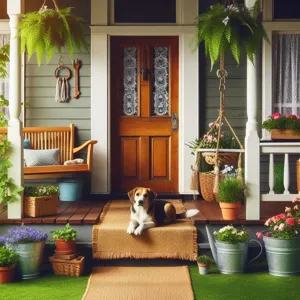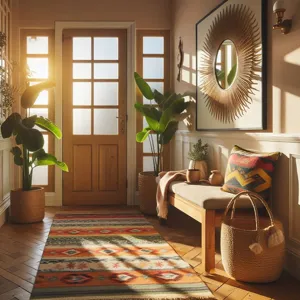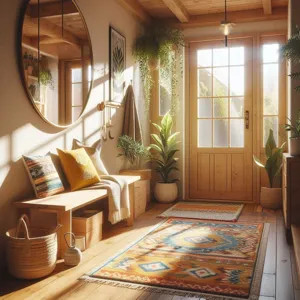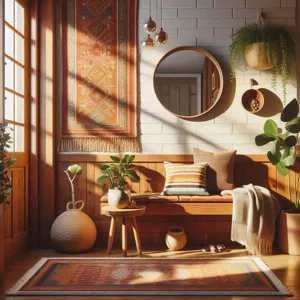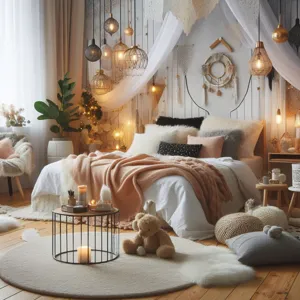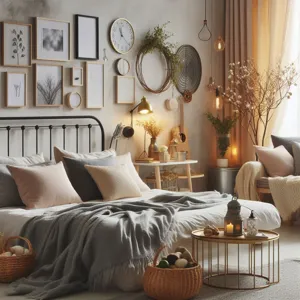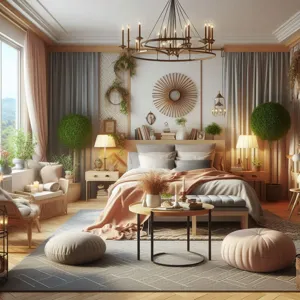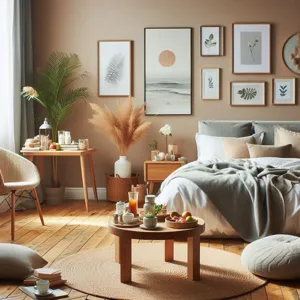Lighting is more than just a functional necessity; it’s a key element that sets the mood, enhances aesthetics, and transforms the atmosphere of any space.
With a myriad of light fixtures available on the market, choosing the right one can feel overwhelming. From the soft glow of pendant lights that create an intimate dining experience to the bright, focused illumination of recessed lighting perfect for workspaces, each type of fixture serves a distinct purpose and style. In this comprehensive guide, we will explore various types of light fixtures, their unique features, and ideal applications, helping you make informed decisions that not only brighten your home but also reflect your personal style. Whether you’re redesigning a room, upgrading your lighting scheme, or simply seeking inspiration, this guide will illuminate your path to creating a beautifully lit environment that caters to your needs and enhances your everyday living.
1. Introduction to Lighting and Its Importance

Lighting is often an overlooked aspect of interior design, yet it plays a pivotal role in shaping the ambiance, functionality, and overall aesthetic of any space. The right lighting can transform an ordinary room into an inviting haven, enhance productivity in a workspace, or create a cozy atmosphere for intimate gatherings. It sets the mood and can influence emotions, making it an essential element in both residential and commercial environments.
Understanding the importance of lighting goes beyond mere illumination. It involves recognizing how different types of light fixtures can serve various purposes, from providing task lighting for focused activities to creating ambient light that envelops a space in warmth. The strategic use of lighting can highlight architectural features, artwork, and decor, drawing attention to the elements you want to showcase while downplaying areas that may not be as visually appealing.
As we delve into this guide, we will explore the diverse types of light fixtures available, each with its unique characteristics and applications. From elegant chandeliers that serve as statement pieces to sleek recessed lights that offer a clean, modern look, each fixture has a specific role to play in enhancing the atmosphere of your home or workplace. Whether you’re redesigning a room, renovating a space, or simply seeking to improve the lighting in your environment, understanding these options will empower you to make informed choices that reflect both your style and functional needs. Join us as we illuminate the world of lighting, helping you navigate the myriad of choices available and discover how to effectively harness the power of light to enhance your daily life.
2. Understanding the Basics: Types of Light Fixtures
When it comes to lighting your space, understanding the different types of light fixtures available is essential for creating a well-lit, functional, and aesthetically pleasing environment. Each fixture serves a specific purpose and brings its unique charm to a room. Here’s a closer look at the primary types of light fixtures and how they can enhance your home or office.
### 1. **Ambient Lighting Fixtures**
Ambient lighting provides the foundational layer of light in any space, establishing a soft glow that illuminates the entire room. Common options include ceiling-mounted fixtures, chandeliers, and wall sconces. These fixtures are designed to offer general illumination, ensuring that every corner of the room is bright enough for day-to-day activities. When selecting ambient lighting, consider the height of your ceilings and the size of your space; larger rooms might benefit from a statement chandelier, while smaller areas may be better suited for flush-mount or semi-flush fixtures.
### 2. **Task Lighting Fixtures**
When you need focused light for specific tasks, task lighting is your go-to solution. These fixtures include desk lamps, under-cabinet lights, and pendant lights, which direct light where it’s needed most. For instance, a well-placed desk lamp can enhance your productivity while working, while under-cabinet lighting can transform a kitchen workspace into a chef’s paradise. Choose adjustable fixtures that allow you to direct light precisely where it’s needed, reducing strain on your eyes and enhancing functionality.
### 3. **Accent Lighting Fixtures**
Accent lighting is all about highlighting features within your space, such as artwork, architectural details, or beautiful plants. Track lighting, spotlights, and wall-mounted picture lights are all excellent choices for creating visual interest and depth. By strategically placing accent lighting, you can draw attention to your favorite decor items and create a layered lighting effect that adds warmth and character to your rooms.
### 4. **Decorative Lighting Fixtures**
While functionality is key, decorative lighting can also serve as a focal point in your design scheme. These fixtures range from ornate chandeliers and artistic pendant lights to whimsical table lamps. They not only provide illumination but also contribute to the overall aesthetic of your space, showcasing your style and personality. When selecting decorative lighting, consider the color, material, and shape to ensure it complements your decor while being a conversation starter.
### 5. **outdoor Lighting Fixtures**
Don’t forget about lighting for the exterior of your home! Outdoor lighting fixtures, such as garden lights, path lights, and wall sconces, enhance your curb appeal while providing safety and security. They allow you to enjoy your outdoor spaces at night, creating an inviting atmosphere for gatherings, barbecues, or quiet evenings under the stars. Look for weather-resistant options to ensure durability and longevity.
By understanding these basic types of light fixtures and their uses, you can make informed decisions that enhance the functionality and beauty of your space. Whether you’re renovating, redecorating, or simply looking to refresh your lighting, the right fixtures can transform your environment and illuminate your lifestyle.
3. Ambient Lighting: Creating a Warm Atmosphere

Ambient lighting serves as the foundation of any well-designed space, creating a warm and inviting atmosphere that enhances the overall comfort of a room. This type of lighting is essential for providing a soft, overall glow that fills the area without overwhelming the senses. Think of it as the gentle embrace of light that welcomes you home after a long day.
When selecting ambient lighting, consider fixtures that diffuse light evenly, such as ceiling-mounted flush or semi-flush lights, chandeliers, or even large floor lamps. These fixtures can be strategically placed to eliminate harsh shadows and create a balanced illumination that softens the edges of furniture and architectural features.
For instance, a stylish pendant light hung over a dining table not only provides functional light for meals but also adds a touch of elegance, encouraging conversation and connection. Similarly, wall sconces can be used to accentuate the architecture of a hallway or living area, casting a warm glow that invites exploration.
In addition to traditional fixtures, consider incorporating other sources of ambient light, such as LED strips placed behind furniture or along shelves, to create a subtle, modern touch. Dimmers are also a fantastic addition, allowing you to adjust the brightness according to the time of day or the mood you want to set, whether it’s a cozy movie night or a lively gathering with friends.
Ultimately, ambient lighting is about establishing a sense of balance and tranquility within your space. By thoughtfully selecting the right fixtures and layers of light, you can transform any room into a welcoming retreat, ensuring that your home feels as inviting as it looks.
4. Task Lighting: Illuminating Workspaces Effectively
Task lighting plays a crucial role in creating functional and efficient workspaces, ensuring that you can focus on the task at hand without straining your eyes. Unlike ambient lighting, which sets the overall mood of a room, task lighting is specifically designed to illuminate areas where precise activities occur, such as reading, writing, cooking, or crafting.
When choosing task lighting, consider fixtures that provide direct, concentrated light to reduce shadows and enhance visibility. Desk lamps with adjustable arms or headlamps are perfect for home offices or study areas, allowing you to direct the light exactly where it’s needed. In kitchens, under-cabinet lighting brightens countertops, making meal prep safer and easier. Similarly, pendant lights hung over a dining table or island not only serve as a stylish statement but also provide focused illumination for meals and gatherings.
The color temperature of task lighting is also essential to consider. Cooler tones, typically in the range of 4000K to 5000K, mimic daylight and are ideal for stimulating productivity, making them perfect for workspaces. Warmer tones, on the other hand, can create a cozy atmosphere in areas where relaxation is key, like reading nooks or lounges.
With the right task lighting, you can significantly enhance your productivity and comfort, transforming any workspace into an inviting and efficient haven. Whether it’s through sleek desk lamps, stylish wall sconces, or practical under-cabinet fixtures, the goal remains the same: illuminate your activities effectively, so you can work smarter, not harder.
5. Accent Lighting: Highlighting Your Home’s Features

Accent lighting serves as the cherry on top of your home’s lighting design, providing the perfect opportunity to showcase your favorite features and create an inviting atmosphere. Unlike general lighting, which fills a space with overall illumination, accent lighting is all about highlighting specific areas or objects, such as artwork, architectural details, or beautiful plants.
When you think of accent lighting, think of it as a spotlight that draws the eye to what makes your home unique. Wall sconces can frame a painting, while adjustable track lighting can illuminate a sculpture or a cherished family heirloom displayed on a shelf. Table lamps with unique designs can serve as both functional lighting and decorative pieces, adding character to a room.
In addition to enhancing aesthetics, accent lighting contributes to the overall mood of a space. Warm, soft lights can create a cozy ambiance in a living room, while brighter, focused beams can energize a workspace or kitchen. Consider using dimmers to adjust the intensity of your accent lights, allowing you to change the atmosphere based on the occasion—whether it’s a lively dinner party or a quiet evening spent reading.
Moreover, accent lighting can significantly impact how we perceive a room’s size and depth. By strategically placing lights at varying heights, you can create layers of light that add dimension to your space, making it feel more inviting and expansive.
Incorporating accent lighting into your home doesn’t have to be complicated. Simple additions, such as LED strip lights under cabinets or behind furniture, can create an ethereal glow that elevates the design of your space. Whether you opt for dramatic lighting to make a bold statement or subtle fixtures to add a touch of elegance, accent lighting is an invaluable tool in crafting a home that not only looks good but feels inviting and lived-in. Embrace the art of highlighting your home’s best features and watch as your spaces transform into beautiful showcases of your personal style.
6. Chandeliers: Elegance and Style for Any Room
Chandeliers have long been synonymous with elegance and grandeur, often gracing the ceilings of opulent ballrooms and lavish dining rooms. However, their versatility has allowed them to find a place in a variety of settings, making them an excellent choice for anyone looking to add a touch of sophistication to their home. Available in an array of styles—from traditional crystal-laden designs to sleek, modern fixtures—chandeliers can enhance the aesthetic of any room, transforming an ordinary space into something extraordinary.
In dining rooms, a well-placed chandelier serves not only as a functional source of light but also as a stunning focal point that sets the tone for gatherings and special occasions. Imagine a beautifully designed chandelier casting a warm, inviting glow over a sumptuous dinner, its crystals shimmering like stars—a perfect backdrop for memorable moments.
Living rooms benefit from chandeliers as well, where they can contribute to the overall ambiance of the space. A contemporary chandelier with clean lines can complement modern decor, while an antique piece can add character to a more traditional setting. Additionally, chandeliers can be used in unexpected places; hanging one in a bedroom can create a romantic atmosphere, while a bold, colorful fixture in a playroom can spark joy and creativity.
When selecting a chandelier, consider the scale of your room. A large chandelier can be a statement piece in a spacious entryway, while smaller fixtures work best in cozy nooks or intimate spaces. The key is to strike a balance; ensure that your chandelier harmonizes with the surrounding decor without overwhelming it.
Beyond aesthetics, chandeliers also offer flexibility in lighting options. Many designs come equipped with dimmer switches, allowing you to adjust the brightness to suit your mood—be it a bright, lively gathering or a soft, intimate dinner.
In essence, chandeliers are more than just light fixtures; they are artistic expressions that elevate the style of any room. Whether you opt for the classic charm of crystal or the sleek sophistication of modern designs, incorporating a chandelier into your home is a surefire way to illuminate your space with elegance and flair.
7. Pendant Lights: Versatility and Design Options

Pendant lights are a shining example of versatility in the world of lighting design. Suspended from the ceiling by a cord, chain, or rod, these fixtures can dramatically transform the ambiance of any space while serving practical lighting needs. Their unique ability to blend functionality with artistic flair makes them a popular choice for various settings, from cozy homes to bustling restaurants.
One of the most appealing aspects of pendant lights is the vast array of design options available. Whether you prefer the sleek lines of modern minimalism or the intricate details of vintage-inspired fixtures, there’s a pendant light to match every aesthetic. For a contemporary look, consider geometric shapes crafted from metal or glass, which can add an air of sophistication to dining areas or kitchens. On the other hand, if you’re aiming for a rustic or industrial feel, pendant lights made from reclaimed wood or exposed Edison bulbs can create an inviting, warm atmosphere.
In terms of functionality, pendant lights can be used in a multitude of ways. Hang a cluster of smaller pendants at varying heights above a kitchen island to create a focal point that doubles as task lighting. A single, oversized pendant can make a bold statement in an entryway or living room, drawing the eye upward and enhancing the sense of space. Additionally, pendant lights work beautifully in dining rooms, providing soft, direct illumination that encourages conversation and connection during meals.
For those who want to experiment with layering light, pendant fixtures can be combined with other sources, such as wall sconces or floor lamps, to create depth and dimension in a room. Consider using dimmable options for added flexibility, allowing you to adjust the brightness according to the occasion, whether it’s a lively dinner party or a quiet evening at home.
In summary, pendant lights are not just a source of illumination—they are a design statement that can enhance the style and functionality of any area. With their diverse styles and adaptable uses, they illuminate the path toward creating inviting, beautifully lit spaces that resonate with your personal taste.
8. Floor and Table Lamps: Functional Decor
When it comes to blending functionality with aesthetic appeal, floor and table lamps are the unsung heroes of interior design. These versatile light fixtures not only illuminate your space but also serve as striking decor pieces that can elevate the overall ambiance of a room.
Floor lamps, with their towering presence, can create drama in a living area or cozy up a reading nook. Available in various styles—from sleek and modern to rustic and industrial—they can complement any décor theme. Imagine a minimalist, angular floor lamp casting a warm glow over a stylish sofa, or a vintage arc lamp creating a soft, inviting corner in a family room. The height of floor lamps allows them to fill the vertical space in a room, drawing the eye upward and creating a sense of openness.
Table lamps, on the other hand, offer a more intimate lighting option, perfect for bedside tables, desks, or side tables in a living room. Their compact design allows them to fit seamlessly into smaller spaces while providing much-needed task lighting for reading, working, or enjoying a cup of tea. With countless designs—from classic ceramic bases to contemporary glass finishes—table lamps can act as statement pieces that reflect your personality and style. A beautifully crafted lamp can serve as a focal point, drawing attention and sparking conversation.
Both types of lamps can be enhanced with various shades, allowing you to control the mood and intensity of the light. A soft, fabric shade diffuses light, creating a warm and cozy atmosphere, while a sleek, metallic shade can provide a more directed beam, perfect for reading or focusing tasks.
Incorporating floor and table lamps into your decor strategy not only enhances the functionality of your spaces but also gives you the opportunity to express your individual style. By thoughtfully choosing these fixtures, you can create a layered lighting design that is both beautiful and practical, ensuring that your home feels warm, inviting, and effortlessly stylish.
9. Wall Sconces: Space-Saving Solutions
Wall sconces are the unsung heroes of lighting design, offering both functionality and flair without consuming precious floor space. These elegant fixtures are mounted directly onto the wall, making them perfect for rooms where space is at a premium or where you want to create a cozy, intimate atmosphere.
Available in a myriad of styles, from sleek modern designs to ornate vintage looks, wall sconces can complement any decor theme. They serve a variety of purposes, whether you need task lighting for reading in a nook, ambient light to soften a room’s overall brightness, or accent lighting to highlight artwork or architectural features.
Imagine a hallway lined with stylish sconces, casting a warm glow that invites guests to explore further. Or picture flanking a mirror in your entryway, where the soft illumination enhances your space while providing practical lighting for last-minute touch-ups before heading out. In living rooms, wall sconces can replace bulky table lamps, freeing up surfaces and allowing for a more streamlined design.
Moreover, many wall sconces are designed to be adjustable, with some featuring swing arms that allow you to direct light exactly where it’s needed. This versatility makes them ideal for bedrooms, where they can be positioned above nightstands for reading without taking up valuable bedside real estate.
Incorporating wall sconces into your lighting plan not only maximizes your space but also adds a layer of sophistication and depth to your home’s ambiance. With their myriad styles, sizes, and functionalities, these fixtures are the perfect solution for anyone looking to enhance their home’s lighting while maintaining a clean and uncluttered aesthetic.
10. Recessed Lighting: Sleek and Modern Choices
Recessed lighting, often hailed as the epitome of sleek and modern design, has become a staple in contemporary interiors. These unobtrusive fixtures, embedded into ceilings, provide a clean and sophisticated aesthetic, making them ideal for various settings — from upscale homes to commercial spaces.
One of the standout features of recessed lighting is its versatility. Available in a range of sizes, shapes, and beam angles, these fixtures can be tailored to suit any room’s needs. Whether you’re aiming to create a warm, inviting atmosphere in your living room or need focused illumination for a kitchen countertop, recessed lights can achieve it all. They can be used to highlight architectural details, artwork, or even specific areas such as a reading nook, seamlessly blending functionality with style.
In addition to their aesthetic appeal, recessed lights are known for their energy efficiency. Many modern options utilize LED technology, which not only consumes less power but also boasts a longer lifespan compared to traditional bulbs. This means you can enjoy beautiful lighting without the hefty energy bills.
Installation is another key aspect of recessed lighting. Though it may require some ceiling modifications, once installed, the fixtures offer a streamlined look that can make a room feel more spacious. With dimmable options available, you can effortlessly adjust the light intensity to suit different occasions, transforming your living space from a bright, lively area for entertaining to a cozy retreat for a quiet evening.
In summary, recessed lighting embodies a sleek and modern choice for illuminating your spaces. Its ability to combine aesthetic elegance with practical benefits makes it an excellent addition to any lighting plan, ensuring your home not only looks stunning but feels inviting and functional.
11. Outdoor Lighting: Enhancing Curb Appeal and Safety
Outdoor lighting serves as a pivotal element in transforming your home’s exterior, seamlessly blending aesthetic appeal with practical safety. When thoughtfully designed, outdoor lighting can boost your home’s curb appeal, making it inviting and warm as dusk falls. Whether you’re illuminating a pathway, accentuating architectural features, or creating cozy outdoor spaces for gatherings, the right light fixtures can work wonders.
**Pathway Lights** are essential for guiding guests safely to your front door. These fixtures, often installed along sidewalks or garden paths, not only enhance safety by illuminating potential trip hazards but also add a charming touch to your landscape. Choose fixtures that are low to the ground, with warm bulbs that create a welcoming glow, and consider solar-powered options for an eco-friendly twist.
**Wall Sconces** and **Floodlights** can accentuate the structure of your home, drawing attention to unique architectural details while providing additional security. Wall sconces mounted on either side of your front door can create a symmetrical and inviting entrance, while floodlights can deter intruders by illuminating dark corners of your property.
**String Lights** and **Lanterns** bring a whimsical touch to patios and gardens. These fixtures create an enchanting atmosphere for outdoor dining or evening socializing, casting a soft, warm light that encourages relaxation and conversation. Consider using dimmable options or smart lighting systems to adjust the ambiance based on the occasion.
In addition to enhancing aesthetics, outdoor lighting plays a crucial role in safety. **Motion Sensor Lights** can automatically illuminate your driveway or yard when someone approaches, providing a sense of security and deterring unwanted visitors. Moreover, well-lit outdoor spaces deter accidents by ensuring that walkways, stairs, and entrances are visible.
Ultimately, outdoor lighting serves a dual purpose: it enhances the beauty of your home while ensuring safety for you and your guests. By carefully selecting and strategically placing your light fixtures, you can create a stunning exterior that beckons visitors while providing peace of mind.
12. Smart Lighting Solutions: The Future of Illumination
In an age where technology seamlessly integrates into our daily lives, smart lighting solutions are emerging as a transformative force in the world of illumination. These innovative fixtures do more than just light up a room; they offer an unparalleled level of control, convenience, and customization that caters to the dynamic needs of modern living.
Imagine entering your home and having the lights automatically adjust to your preferred brightness and color temperature, all thanks to sensors and smart technology that respond to your presence. Smart lighting systems can be controlled via smartphone apps, voice commands, or even automated schedules, allowing homeowners to create the perfect ambiance for any occasion. Whether you’re hosting a dinner party, winding down for the evening, or waking up in the morning, you can easily set the mood with a simple tap or voice prompt.
Moreover, smart lighting solutions are not just about aesthetics; they are also designed with energy efficiency in mind. Many of these fixtures utilize LED technology, which consumes significantly less power than traditional bulbs. With features like dimming capabilities and the ability to turn lights off remotely, smart lighting can help reduce your energy costs while also contributing to a more sustainable environment.
Additionally, smart lighting can enhance your home’s security. Many systems offer features like motion detection and the ability to simulate occupancy by scheduling lights to turn on and off at specific times. This deters potential intruders and provides peace of mind when you’re away from home.
As the future of illumination unfolds, embracing smart lighting solutions can transform your living spaces into intelligent environments that adapt to your lifestyle. Whether you’re looking to increase efficiency, enhance security, or simply enjoy customizable lighting experiences, smart fixtures are a worthwhile investment for any modern home. So, step into the future of lighting and illuminate your spaces with the brilliance of technology.
13. Choosing the Right Bulbs: LED vs. Incandescent
When it comes to illuminating your space, the choice of light bulbs can have a significant impact on both the ambiance and energy efficiency of your home. The two most popular options on the market today are LED (Light Emitting Diode) and incandescent bulbs, each offering distinct advantages and characteristics that cater to different needs and preferences.
**LED Bulbs** have surged in popularity over the past decade, and for good reason. These energy-efficient powerhouses consume up to 80% less energy than traditional incandescent bulbs, translating into substantial savings on your electricity bill over time. Additionally, LED bulbs boast an impressive lifespan, often lasting up to 25,000 hours compared to the mere 1,000 hours typical of incandescent options. This means fewer trips to the store and less waste, making LEDs a more environmentally friendly choice. Furthermore, LEDs are available in a range of color temperatures, from the warm glow of a candle to the bright white light reminiscent of midday sun, allowing for versatility in creating the desired mood in any room.
On the other hand, **Incandescent Bulbs**, though less energy-efficient, offer a warmth and quality of light that many people find appealing. The soft, inviting glow of incandescent lighting can create a cozy atmosphere, making it a popular choice for living rooms and bedrooms. They are also typically less expensive upfront than their LED counterparts, which can be attractive for those looking to make quick, budget-friendly lighting decisions. However, it’s essential to consider that these bulbs have a shorter lifespan and higher energy costs in the long run, which may offset their initial affordability.
Ultimately, the decision between LED and incandescent bulbs comes down to your specific lighting needs, budget, and preferences. If you prioritize energy efficiency, longevity, and versatility, LEDs are the clear winner. Conversely, if you’re seeking a warm, traditional glow for your home, incandescent bulbs may be your go-to choice. Whichever you choose, understanding the benefits and limitations of each will empower you to make informed decisions that enhance your space’s beauty and functionality.
14. Tips for Layering Light in Your Space
Layering light in your space is an art that can transform the ambiance and functionality of any room. By combining different types of lighting—ambient, task, and accent—you create a dynamic environment that meets various needs while enhancing the aesthetic appeal of your home. Here are some practical tips to help you master the art of layered lighting.
**Start with Ambient Lighting**: Ambient lighting serves as the foundation of your lighting scheme, providing general illumination for the entire room. Consider ceiling-mounted fixtures, chandeliers, or recessed lighting to establish a warm, inviting glow. Dimmers can be your best friend here, allowing you to adjust the brightness depending on the time of day or the mood you wish to create.
**Incorporate Task Lighting**: Once the ambient layer is set, it’s time to focus on task lighting—fixtures that provide direct light for specific activities. Think desk lamps for reading, under-cabinet lights in the kitchen for food prep, or wall sconces beside your bed for nighttime reading. Task lighting should be strategically placed to reduce shadows and enhance visibility where it’s most needed.
**Add Accent Lighting**: To further elevate the atmosphere, introduce accent lighting to highlight features of your space. This could be a stylish pendant light over a dining table, LED strip lights illuminating shelves of decorative items or artwork, or spotlights that draw attention to architectural details like a fireplace or a textured wall. Accent lighting adds depth and character, making your space feel more curated and inviting.
**Consider the Color Temperature**: The color temperature of your light fixtures plays a crucial role in the overall feel of the room. Warmer lights (around 2700K-3000K) create a cozy and intimate ambiance, ideal for living rooms and bedrooms, while cooler lights (4000K or higher) are perfect for workspaces or kitchens where clarity and focus are essential. Mixing different color temperatures within your layered lighting design can create a balanced and interesting visual effect.
**Use Dimmer Switches Wisely**: Installing dimmer switches can significantly enhance the versatility of your lighting. By adjusting the intensity of each layer of light, you can easily transition from a bright, energetic environment during the day to a soft, relaxing glow at night. This adaptability ensures that your space feels comfortable and inviting, regardless of the occasion.
**Keep Scale and Proportion in Mind**: Finally, remember that the size and scale of your light fixtures should complement the dimensions of the room. A large chandelier can serve as a stunning focal point in a grand dining room, while a cluster of smaller pendant lights might work better in a cozy kitchen nook. Ensuring that your lighting choices are proportional to the space will help create a harmonious design.
By thoughtfully layering different types of lighting, you can effortlessly enhance both the functionality and aesthetic charm of your home, creating spaces that are not only well-lit but also warm, inviting, and uniquely yours.
15. Conclusion: Making Informed Choices for Your Lighting Needs
In conclusion, making informed choices for your lighting needs is essential to create the perfect ambiance and functionality in your spaces. As we’ve explored throughout this guide, the variety of light fixtures available today can cater to an array of styles, preferences, and practical requirements. From the sleek elegance of pendant lights that illuminate kitchen islands, to the warm glow of table lamps that enhance cozy reading nooks, each fixture plays a pivotal role in shaping the atmosphere of your home or office.
Understanding the purpose of each type of light fixture—whether it’s task lighting for focused activities, ambient lighting for overall illumination, or accent lighting to highlight artwork—empowers you to select the right pieces that align with your vision. Consider the scale of your rooms, the color schemes, and the specific needs of each area before making a decision. Additionally, don’t overlook the significance of energy efficiency and the latest innovations in LED technology, which offer longevity and sustainability without sacrificing style.
Ultimately, the choices you make in lighting affect not just the aesthetics of your space but also its functionality and your overall well-being. By taking the time to assess your lighting needs and exploring the myriad of options available, you can create an inviting, well-lit environment that enhances both comfort and productivity. Illuminate your life with thoughtful lighting choices that reflect your personal style and meet the demands of your everyday activities.
In conclusion, we hope this guide to different types of light fixtures has illuminated your understanding of how to enhance your spaces with the perfect lighting solutions. From the warm ambiance of pendant lights to the task-oriented brilliance of recessed fixtures, each type serves a unique purpose and can dramatically transform the atmosphere of any room. As you embark on your lighting journey, remember to consider both functionality and aesthetics, ensuring that your choices not only meet your practical needs but also reflect your personal style. With the right fixtures, you can create inviting, dynamic environments that brighten up your home and elevate your daily experiences. Thank you for joining us on this exploration of light—may your choices be inspired and your spaces beautifully lit!

